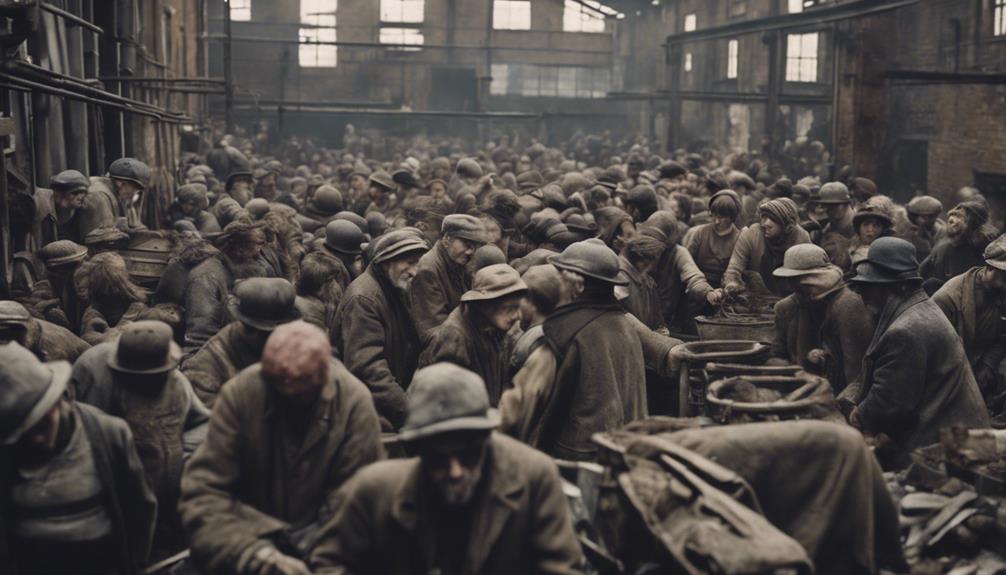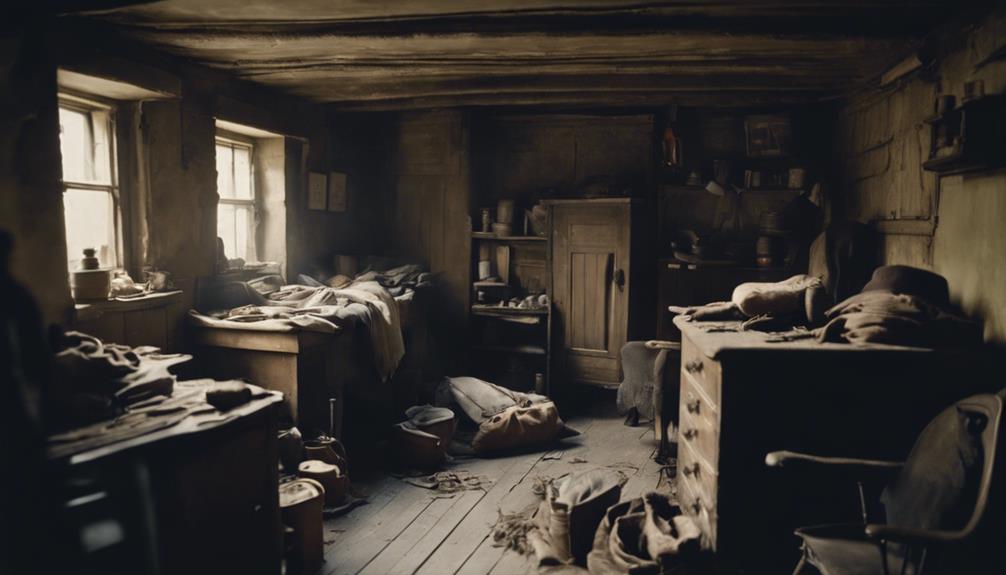What Impact Did Industrial Revolution Have on Staffordshire?
The Industrial Revolution deeply impacted Staffordshire. Child labor thrived in pottery workshops, affecting health and education. Poor working conditions exposed workers to hazards. Lead exposure and unsanitary conditions posed health risks. Lack of safety regulations caused accidents. Economic struggles, low wages, and challenging living arrangements were common. Historical events shape modern-day Staffordshire, evident in diverse industries and a manufacturing hub. Infrastructure development and cultural heritage reflect the revolution's lasting influence. The legacy of industrialization persists, contributing to economic vitality. Continued exploration reveals the intricate web of effects on Staffordshire's past and future.
Key Takeaways
- Child labor prevalent in pottery industry.
- Poor working conditions affected worker health.
- Lead exposure and health risks in factories.
- Educational deprivation due to child labor.
- Economic struggles and need for reforms.
Child Labor in Pottery Industry
Child labor profoundly impacted the pottery industry in Staffordshire, shaping the lives of young workers in significant ways. Children as young as five or six weren't uncommonly found toiling for long hours in dusty and damp workshops, aiding in various tasks vital for family survival.
These young workers, often working 12+ hours a day, played a crucial role in contributing to the household income. However, this practice took a toll on child development and welfare. The heavy lifting and exposure to extreme temperatures in the pottery industry affected their health, growth, and education.
The impact of child labor on these aspects of their lives was profound, highlighting the challenges faced by young laborers during the Industrial Revolution. Despite being essential for many families' financial stability, the toll on children's well-being was undeniable.
The pottery industry's reliance on child labor had far-reaching consequences that went beyond economic necessity, significantly shaping the lives of these young workers in Staffordshire.
Poor Working Conditions
Workers in Staffordshire faced severe health hazards in factories due to exposure to lead and poor ventilation.
Long hours, low pay, and lack of protective gear exacerbated the physical toll on workers.
The demanding nature of industrial work in Staffordshire led to exhaustion and compromised well-being among workers.
Health Hazards in Factories
Amidst the Industrial Revolution's rapid expansion in Staffordshire, the grim reality of poor working conditions in factories posed significant health hazards to those laboring within them.
- Workers in Staffordshire factories faced health hazards such as lead exposure due to the materials used in pottery production.
- Poor ventilation and long working hours in factories contributed to respiratory issues and overall health deterioration.
- Workers, including children, endured harsh conditions in damp and dusty environments, leading to increased risks of lung diseases.
- Lack of safety regulations and protective gear resulted in frequent accidents and injuries among factory workers.
- The prevalence of poor working conditions in Staffordshire factories highlighted the urgent need for labor reforms to protect workers' health and well-being.
Long Hours, Low Pay
The toll of enduring long hours and receiving meager pay during the Industrial Revolution in Staffordshire exacerbated the hardships faced by laborers in various industries.
Workers often toiled for more than 12 hours a day, struggling with low wages that made it challenging to make ends meet. In industries like pottery and coal mining, poor working conditions added to the difficulties faced by workers.
This combination of demanding schedules, inadequate pay, and unsafe workplaces took a severe toll on the physical and mental well-being of laborers. The harsh realities of poor working conditions highlighted the urgent need for worker solidarity and labor reforms in Staffordshire during this era.
Strengthening bonds among workers and advocating for improved protections became vital in the fight for better working conditions and fair treatment.
Impact on Health and Growth

The Industrial Revolution in Staffordshire significantly impacted the overall health and growth of individuals laboring in its factories and industries. Workers faced numerous challenges that affected their well-being, including:
- Public Health: The unsanitary conditions in factories posed a threat to the workers' health, leading to the spread of diseases and illnesses.
- Nutritional Deficiencies: Long hours of work and meager wages meant that many workers struggled to afford proper nutrition, resulting in deficiencies that affected their growth and overall health.
- Lead Exposure: The prevalence of lead in pottery factories had severe health consequences, with workers suffering from lead poisoning that stunted their growth and caused long-term health issues.
- Safety Measures: The lack of safety regulations in industrial settings increased the risk of accidents and injuries, impacting the physical well-being and growth of workers.
- Child Labor: Children employed in factories, particularly in the pottery industry, experienced stunted growth and health problems due to the harsh working conditions and prolonged hours they were subjected to.
Educational Deprivation
During the Industrial Revolution in Staffordshire, children faced limited access to education due to long working hours in the pottery industry. Illiteracy became common among child laborers as work took precedence over schooling.
Sparse educational opportunities exacerbated the educational inequalities and lack of resources for children in the industrial sector of Staffordshire.
Impact on Literacy
Amid the industrial chaos of Staffordshire, children toiled in factories, their literacy aspirations overshadowed by the demands of relentless labor. This led to a significant impact on literacy in the region, with child labor hindering educational opportunities for young workers.
The pottery industry, known for employing children, especially contributed to the prevalence of illiteracy among these laborers. Educational deprivation was a common consequence of the industrial settings these children were subjected to, prioritizing work over learning.
The need for child labor for family survival often meant that educational opportunities were neglected, perpetuating a cycle of illiteracy in Staffordshire during the Industrial Revolution.
- Child labor hindered literacy development.
- Illiteracy was prevalent among young workers.
- Educational opportunities were neglected in industrial settings.
- The focus on work overshadowed literacy aspirations.
- Harsh industrial conditions perpetuated educational deprivation.
Educational Inequalities
In Staffordshire, children's access to education was severely limited by the demands of industrial work during the era of the Industrial Revolution. Many kids had to forgo formal schooling to work in factories and mines, impacting their opportunities for learning.
This educational deprivation among working-class families had generational effects, perpetuating a cycle of limited social mobility and reinforcing poverty. The focus on economic growth often overshadowed the importance of education, leading to long-term inequalities in the region.
The lack of resources allocated to schooling during this time further exacerbated the situation, creating barriers for children to break free from the cycle of educational deprivation. The industrialization of Staffordshire prioritized work over learning, leaving a lasting impact on the educational landscape and opportunities available to youngsters.
Lack of Resources
Limited educational resources exacerbated the educational deprivation experienced by children in Staffordshire during the Industrial Revolution. This lack of resources intensified the educational obstacles and learning challenges faced by young individuals working in industries. Consider the following:
- Children had limited access to formal education due to being part of the industrial workforce.
- High illiteracy rates were prevalent among child laborers due to the scarcity of educational opportunities.
- The demanding nature of industrial work left little time for children to focus on learning and literacy.
- The prioritization of work over education contributed to a cycle of limited learning opportunities for these young workers.
- Educational resources were insufficient and inadequate for the educational needs of children engaged in industrial labor in Staffordshire.
Economic Struggles
During the Industrial Revolution in Staffordshire, the traditional industries grappled with economic challenges due to increased competition and technological advancements. The shift towards mechanization and modernization disrupted the established economic patterns, leading to unemployment challenges and financial struggles for many workers. The move to new industries created uncertainty and hardships, highlighting the need for economic diversification in Staffordshire.
| Economic Struggles in Staffordshire |
|---|
| – Increased competition |
| – Technological advancements |
| – Unemployment challenges |
| – Financial hardships |
| – Need for economic diversification |
The economic struggles faced during the Industrial Revolution emphasized the necessity for adapting to the changing times. Workers in Staffordshire encountered difficulties as traditional industries declined, pushing them towards seeking new opportunities and skills. The challenges of this period laid the foundation for a shift towards a more diverse and resilient economy in Staffordshire, paving the way for future growth and development.
Poverty and Illiteracy Cycle

Child labor in Staffordshire during the Industrial Revolution perpetuated a vicious cycle of poverty and illiteracy. Families depended on the income of their children, sacrificing their education to make ends meet.
This lack of access to schooling further entrenched the struggles of poverty, creating a challenging cycle for future generations.
Impact on Education
The pervasive influence of industrialization in Staffordshire had a profound impact on the educational landscape, particularly perpetuating a cycle of poverty and illiteracy. Despite the challenges faced, efforts were made to address these issues through various means:
- Limited access to education hindered by child labor perpetuated illiteracy.
- Child labor in pottery factories hindered educational opportunities for children.
- The cycle of poverty forced children to work instead of attending school.
- Illiteracy prevalence among child workers in Staffordshire due to survival focus.
- Dire circumstances of families relying on child labor perpetuated poverty and illiteracy.
These factors intertwined to create a challenging environment for educational reforms and literacy initiatives in industrial Staffordshire.
Cycle of Deprivation
Generations in industrial Staffordshire were ensnared in a relentless cycle of poverty and illiteracy, perpetuated by the harsh realities of child labor and limited educational opportunities.
The cycle of deprivation stemmed from the necessity of child labor for survival, hindering access to education and perpetuating generational poverty. Families faced systemic challenges as the focus shifted towards immediate financial needs, leaving little room to break free from the cycle of illiteracy.
This cycle had profound societal implications, creating long-term barriers to social mobility and economic progress.
The prevalence of child labor in industrial Staffordshire reinforced educational barriers, making it difficult to address the root causes of poverty and illiteracy, leading to a continuous cycle of deprivation for many families in the region.
Socioeconomic Struggles
Amidst the industrial upheaval in Staffordshire, a pervasive cycle of poverty intertwined with illiteracy plagued families grappling with socioeconomic hardships. In the midst of these socioeconomic challenges, generational poverty perpetuated a cycle that was difficult to break.
The struggle to make ends meet often forced parents to prioritize work over their children's education, leading to high levels of illiteracy among the younger generation. Child labor became a harsh reality for many families facing unemployment and illness, as children were pushed into the workforce to support their households.
The dire circumstances of the mid-19th century underscored the deep-rooted issues of poverty and illiteracy in Staffordshire, highlighting the need for systemic change.
Factory Living Arrangements

Factory workers in Staffordshire endured cramped, unsanitary living conditions in housing provided by their employers during the Industrial Revolution. The housing conditions were often overcrowded, with multiple families sharing limited space and facilities. Lack of proper ventilation, sanitation, and basic amenities made daily life challenging for these workers.
Issues like inadequate heating, dampness, and lack of privacy were prevalent in their small living quarters. The rapid growth of factory towns in Staffordshire during this time worsened the already difficult housing situation. Despite these challenges, some sense of community support could be found among the workers who shared similar living conditions.
The urban planning of factory living arrangements lacked consideration for the well-being of the workers, focusing more on maximizing space and efficiency. This led to a significant impact on the quality of life for those living in these cramped and substandard conditions.
Influence on Family Dynamics
The Industrial Revolution in Staffordshire significantly altered the dynamics of families as they navigated the increased reliance on child labor for household income. During this period, family cohesion and social dynamics underwent profound changes, reshaping the way households operated and interacted.
The intergenerational impact of children working alongside parents and siblings in the pottery industry led to cultural shifts within families, where economic pressures often outweighed the importance of education. To understand the influence on family dynamics during this era, consider the following:
- Family cohesion: The need for children to contribute to the family income strengthened bonds but also blurred traditional roles.
- Social dynamics: The division between work and family life became increasingly blurred as entire families worked together in factories.
- Intergenerational impact: Children's labor not only affected their immediate family but also shaped future generations' views on work and education.
- Cultural shifts: The prioritization of work over schooling altered the cultural values surrounding learning and literacy.
- Economic pressures: Families faced immense pressure to rely on child labor for survival, perpetuating cycles of poverty and limiting opportunities for socioeconomic advancement.
Social Repercussions

Social repercussions of widespread child labor during the Industrial Revolution in Staffordshire extended beyond economic considerations to profoundly impact societal norms and well-being.
The community felt the strain as children as young as five or six toiled in factories, their presence altering the fabric of daily life. The acceptance of child labor as a necessary evil for survival led to a normalization of harsh working conditions and physical punishment, corroding the social fabric.
Families, struggling with economic hardships, found themselves trapped in cycles of poverty and illiteracy, perpetuating a bleak future for generations. The impact on community well-being was palpable, with health and education suffering as resources were diverted to mere subsistence.
However, these grim realities sparked a wave of social reform movements aimed at challenging the status quo and advocating for the rights of vulnerable populations. The call for change echoed through the streets of Staffordshire, laying the groundwork for a shift towards a more equitable and compassionate society.
Long-Term Consequences
Amidst the economic growth and industrial transformation brought about by the Industrial Revolution in Staffordshire, the long-term consequences have left an indelible mark on the county's landscape and cultural identity. The legacy of this period continues to shape Staffordshire in various ways:
- Diverse Industries: The establishment of industries like pottery, coal mining, and engineering laid the foundation for a diverse economic landscape that persists today.
- Manufacturing Hub: Staffordshire's evolution into a key manufacturing hub during the Industrial Revolution has had lasting effects on the county's economic prosperity.
- Infrastructure Development: The changes in infrastructure and transportation systems brought about by the industrial advancements have influenced urban development and connectivity in Staffordshire.
- Industrial Heritage: The rich industrial heritage of Staffordshire, preserved through museums and historical sites, serves as a reminder of the county's industrial past.
- Continued Presence: The manufacturing industries, trade networks, and cultural traditions that originated during the industrial revolution still thrive, contributing to the county's unique identity and economic vitality.
Conclusion
To sum up, the Industrial Revolution had a significant impact on Staffordshire. This impact resulted in child labor in the pottery industry, substandard working conditions, health issues, educational deprivation, economic struggles, and alterations in family dynamics.
The social repercussions and enduring consequences of these changes continue to be experienced in the region today. It's vital to comprehend the historical context of these events to understand the challenges faced by individuals during this transformative period.

